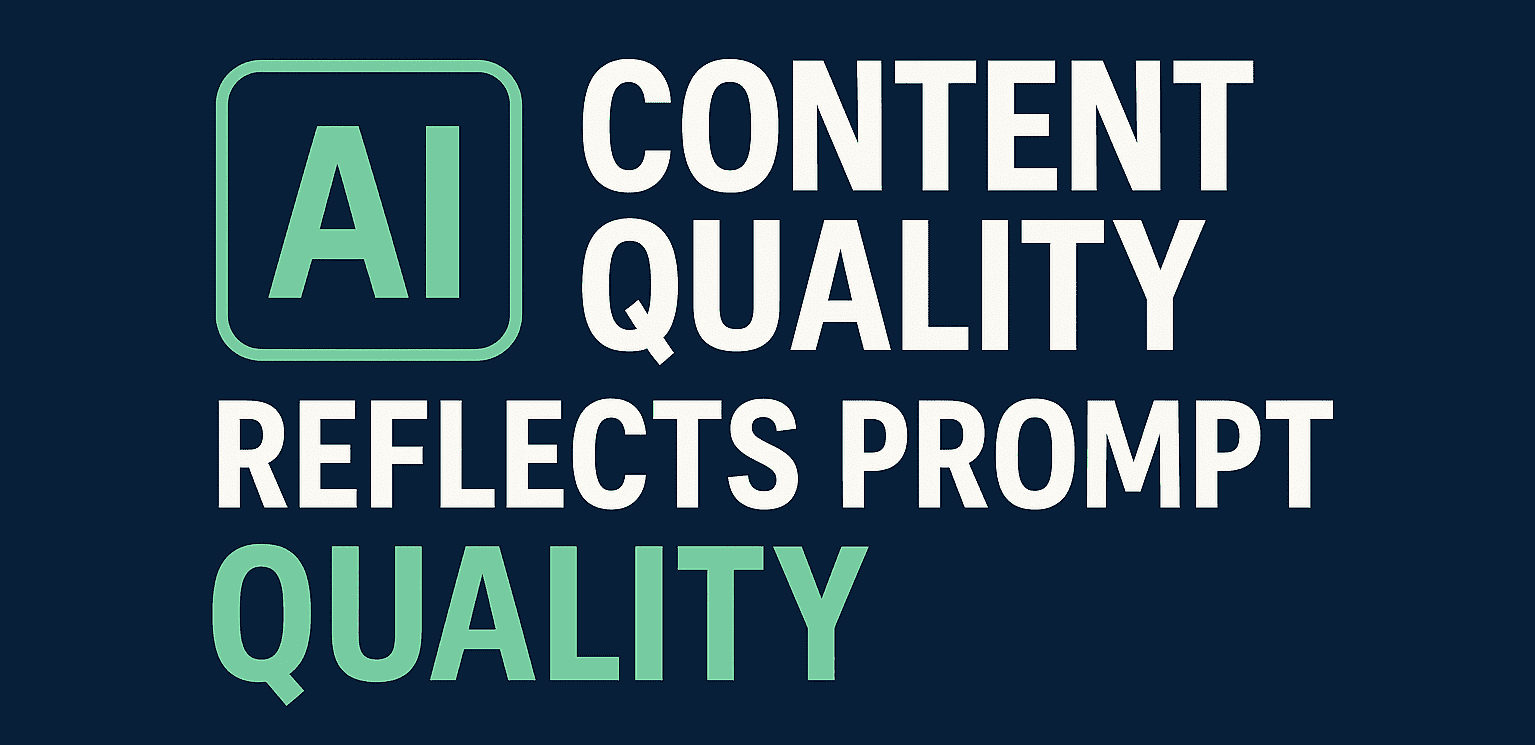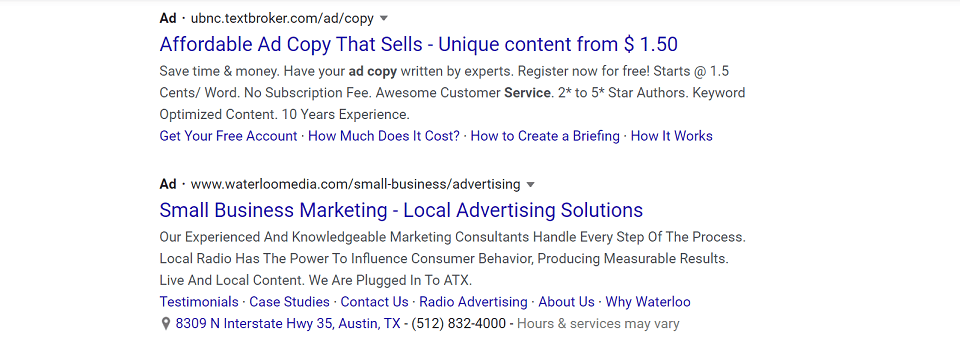Marketers have a habit of blaming problems they face on the tools they used to manage various tactics.
If a campaign flops, it’s the platform’s fault. If results lag, it’s the algorithm.
And lately, when an AI draft falls flat, it’s “because ChatGPT is generic.”
But let’s face it…that’s not the case. The truth is simpler, yet hard to swallow.
The quality of your AI content reflects the quality of your prompts.
If you give the model a vague task with unfocused direction, you’ll get vague output.
However, when you approach it like a junior copywriter who needs clear oversight, you’ll get results that actually move the needle.
This post breaks down why prompt quality is the single biggest factor in AI content performance, and what you can do to fix it.
Why Marketers Struggle With AI Output
Marketers want speed. You sit down, type a quick request, and expect polished copy in seconds.
But you wouldn’t hire a freelancer, say “write me something about our product,” and expect them to create magic without direction.
So why would you take a more lax approach when asking AI to write your content?
The most common mistakes look familiar:
- Asking for an article or post without specifying its purpose
- Forgetting to designate a target audience
- Omitting direction about format or tone you want to see
- Failing to set constraints, such as structural or word count minimum / maximum
Each of these shortcuts nudges the model toward filler output. The result is content that looks like every other generic post online.
It’s not because the model can’t do better. It’s because you didn’t ask it to.
Example 1: Campaign Brief Prompt
Bad Prompt:
“Write me a campaign brief for our new product.”
Bad Output (snippet):
“Our new product is exciting. This campaign will highlight its features and benefits. We will reach customers through social media and email.”
That’s a paragraph, not a brief.
Better Prompt:
“You are a marketing strategist writing a campaign brief for a new skincare serum. The audience is women 30–45 years old who care about all-natural ingredients. Write a 200-word brief with campaign objectives, primary messaging, and the top channels we should target to reach them.”
Better Output (snippet):
“Campaign Objective: Drive awareness and trial of the new Bright Glow Serum among women ages 30–45 who prefer natural skincare.
Primary Message: Achieve visible radiance with clean, plant-based ingredients.
Top Channels: Instagram Reels, influencer partnerships, and targeted email to people who have purchased skincare products from us before.”
That’s a brief you can build from.
Example 2: Persona-Driven Content Prompt
Bad Prompt:
“Write a blog post about email marketing.”
Bad Output (snippet):
“Email marketing is important for businesses. It allows companies to connect with customers and drive sales. Many companies use email as a marketing channel.”
Meh, that’s just…well…blah.
Better Prompt:
“You are writing for B2B SaaS marketers. Write a blog post about email marketing strategies that help reduce churn. Include three examples of campaigns that retain customers, and don’t just focus on how to sell to them. Keep it under 1,000 words.”
Better Output (snippet):
“Most email marketing advice focuses on acquisition. For SaaS companies, retention is where the real growth happens. Three campaigns that cut churn: onboarding series that guides new users through setup, usage reports that highlight features customers might miss, and renewal reminders with customer success stories to reinforce value.”
Now you have content that speaks to a real audience and a real outcome.
Example 3: Content Calendar Prompt
Bad Prompt:
“Make me a content calendar.”
Bad Output (snippet):
“Week 1: Blog post about our product.
Week 2: Social media posts about our product.
Week 3: Email about our product.”
That isn’t a calendar. It’s a list.
Better Prompt:
“You are a content strategist for a mid-sized B2B company in the HR tech space. Build a one-month content calendar with four blog topics, four LinkedIn posts, and two email themes. Tie each piece to the theme of employee retention.”
Better Output (snippet):
Week 1 Blog: “Why retention starts before onboarding”
Week 1 LinkedIn: Quick tip on retention drivers
Week 2 Blog: “How HR tech can reduce turnover costs”
Week 2 LinkedIn: Chart on average cost of attrition
Week 3 Email: Success story highlighting customer retention gains
Week 4 Blog: “Building a retention culture in hybrid teams”
Week 4 LinkedIn: Quote from HR leader on retention best practices
Now you have structure, variety, and purpose. This is something you can do a month long push on to establish a clear, multi-touchpoint campaign.
Example 4: Ad Copy Prompt
Bad Prompt:
“Write ad copy for a marketing agency.”
Bad Output (snippet):
“We are the best marketing agency. We help businesses grow with our services. Contact us today.”
Copy like that won’t perform…not onebit.
Better Prompt:
“Write three Google Ads headlines and two descriptions for a digital marketing agency in Austin that helps HVAC companies win at local SEO. Focus on calls, leads, and local visibility.”
Better Output (snippet):
Headline: “Get More HVAC Calls in Austin”
Headline: “Local SEO That Drives Leads”
Headline: “Your Customers Are Searching. We Help Them Find You”
Description: “Boost your HVAC company’s visibility on Google. Win local leads without wasting money on ads.”
Description: “Our Austin-based team specializes in HVAC SEO. Call us today to see how many more calls you can get.”
That’s targeted copy a client could actually run.
Example 5: Webinar Landing Page Prompt
Bad Prompt:
“Write a landing page for a webinar.”
Bad Output (snippet):
“Join our webinar to learn more about marketing. Sign up today to reserve your spot.”
Generic and forgettable. And this is to be expected since the AI tool had zero guidance on any details about the webinar itself.
Better Prompt:
“You are a copywriter for a B2B SaaS company hosting a webinar on customer retention. Write a landing page with a strong headline, three key takeaways, and a call-to-action to register. Keep it under 250 words.”
Better Output (snippet):
“Webinar: Stop Losing Customers: Proven Retention Strategies for SaaS
Three things you’ll learn: how onboarding shapes retention, which lifecycle campaigns reduce churn, and why customer success should own renewal messaging.
Reserve your spot today to learn from retention experts who have cut churn by 30%.”
That’s a page built to drive interest and signups.
Example 6: LinkedIn Carousel Prompt
Bad Prompt:
“Make me a LinkedIn post about brand awareness.”
Bad Output (snippet):
“Brand awareness is important. It helps people know about your company. You should use social media to increase brand awareness.”
Again, meh. No one will pay attention at all.
Better Prompt:
“You are a social media manager creating a LinkedIn carousel for B2B marketers. Write five slides that explain why brand awareness campaigns fail and how to fix them. Use short, punchy copy.”
Better Output (snippet):
Slide 1: “Why Your Brand Awareness Campaigns Don’t Work”
Slide 2: “Are you targeting everyone, except your buyer?”
Slide 3: “Measuring impressions, but not engagement?”
Slide 4: “Talking about features, and not benefits or value?”
Slide 5: “Fix it by narrowing audience, tracking engagement, and focusing on outcomes”
Now you have a carousel that sparks conversation, instead of everyone just scrolling by.
Why Prompt Quality Matters for Marketing Results
The gap between a bad prompt and a good one isn’t just stylistic.
It affects performance.
Clearer messaging cuts through noise in crowded feeds.
Persona-driven prompts produce content that resonates with decision-makers, which increases engagement and conversions.
Structured prompts generate campaigns that look consistent across channels, reinforcing brand trust.
Strong constraints prevent bloat and shallow content, so your copy lands tighter and faster.
By improving your prompt quality, you can boost every metric we marketers use to track success.
Consider open rates, CTRs, conversion rates, cost per lead, and pipeline velocity, for example.
Each of these KPIs hinges on whether or not the content actually resonates.
Poor prompts set you up for weak numbers.
But strong prompts, now those give you a real shot at outperforming competitors.
The Marketer’s Prompt Playbook
The path to better prompts isn’t rocket science. It’s rather simple and methodical.
Here are the things you should be considering. Think of this as your checklist before you hit “Enter.”
- Define the role: who should the AI act as; strategist, copywriter, media planner
- Name the audience: CMO, small business owner, HR director
- Specify the format: blog, email sequence, ad set, social carousel
- Set the constraints: word count, tone, must-have elements
- Tie it to outcomes: what metric should this piece influence
Every strong marketing prompt covers these five areas.
Miss one, and you’ll drift back into generic territory.
Closing Thoughts
The harsh truth is that prompt quality decides output quality.
If your prompts are weak, your content will be weak. If your prompts are clear, your content will perform.
Stop blaming the tool. Start taking control of how you use it.
If you want to move beyond average AI output and create marketing content that actually drives campaigns forward, reach out.
I’ll show you how to prompt like a marketer who knows what outcomes matter.
Tommy Landry
Latest posts by Tommy Landry (see all)
- What Is an SEO Proposal and What Should It Include? - December 2, 2025
- The Complete Guide to Dental SEO: How Dentists Can Attract More Local Patients Online - November 25, 2025
- How AI Is Changing eCommerce SEO and Product Discoverability - November 20, 2025





